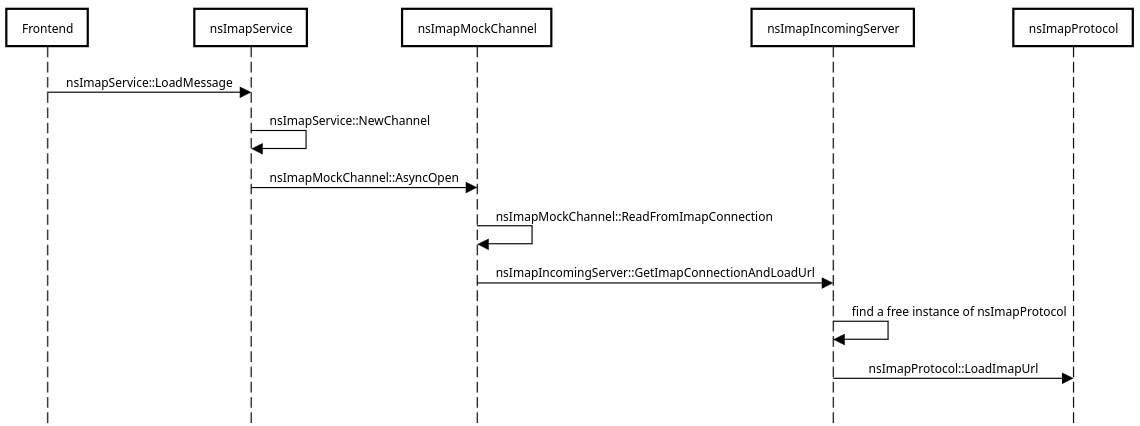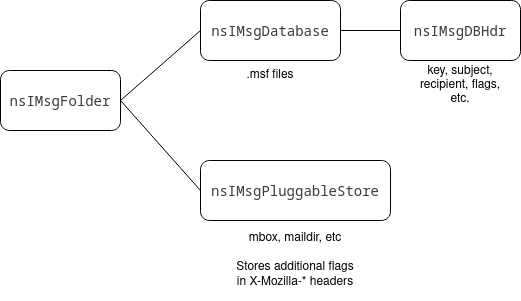Implementation architecture for email protocols
This document describes the code architecture used by protocol implementations in Thunderbird. Its aim is to give more insight into existing protocol implementations, by summarizing the interactions between the involved components, and illustrating with the example of the IMAP protocol implementation.
This document was initially written during the exploratory phase of the Exchange protocol implementation into Thunderbird, when it became clear that our understanding of what a protocol is within Thunderbird was insufficient to tackle this project.
While the initial research has allowed us to build a solid base of documentation on this topic, this is still very much a living document, as there will very likely be more discoveries made and lessons learned while working through actual protocol implementations.
Therefore, this document should be considered a work in progress for now.
Overview
Components
These are the main components used to implement a protocol. The frontend is generic enough to not require protocol-specific component implementations.
URL (
nsIURL): Static description of a resource following a spec defined by the protocol implementation (therefore it might not correspond to resource identifiers defined by the protocol’s specification, and might translate to more than one operation on the remote server). Sometimes it is given additional structures such as message sinks, channels, etc.Message service (
nsIMsgMessageService): Abstraction layer that is capable of parsing the string representation of a URL. Also provides APIs to run specific messaging-related operations (load message, delete folder, edit message flags (if relevant), search, etc) by turning them into URLs.Channel (
nsIChannel): Asynchronous layer enabling communication between a service (or other parts of the backend) and a server. The channel has the same lifetime as the request being made, and carries its parameters to the connection, as well as any listener or event sink needed to ferry messages back to the caller. It is able to start in a held state until a connection becomes available.Incoming server (
nsIMsgIncomingServer): Represents a single server to talk to. Keeps track of the data needed to connect to the server (address, credentials, connectivity status, etc), as well as a connection pool.Protocol / Connection: The component that actually talks to the socket, by implementing the protocol’s specification. Turns the URL into a set of operations, runs them, then feeds data back to other stakeholders via listeners and event sinks. This class is designed after the specific needs of the protocol that is being implemented, rather than based on an existing interface/class in order to mutualize code (which has created complications historically).
Folder (
nsIMsgFolder): Represents a single folder on the server. Provides APIs for performing common operations on/interacting with the folder, thus providing abstraction on the storage side of the operation/interaction.Database (
nsIMsgDatabase): Stores the metadata and headers related to messages received.Message store (
nsIMsgPluggableStore): Stores the content of the messages received.
Relationship between components
The frontend interacts with the backend in two ways:
By calling upon the message service to trigger operations that require interaction with the server
By interacting with a global instance of
nsMsgDBView(often wrapped into an instance ofDBViewWrapper) to operate on the message database/store, usually through annsIMsgFolderinstance.
When the message service receives a call, it sends the request through a
channel. This call usually comes with a string representation of the URL for a
folder or message (or other entity, depending on the protocol), or multiple
depending on the operation. The channel is created either directly, or via
nsIDocShell::LoadURI if the frontend provides the message service with an
object which implements nsIDocShell (sometimes referred to as a display
consumer), and if the operation involves fetching a resource at the given URL.
Attached to the URL are potential parameters for the request, as well as event sinks and listeners (which can be provided by the frontend directly) that can be used to inform the frontend (or other intermediate party) about the state of the operation and communicate any resulting data. In future implementations (or when reworking existing ones), these really should be attached to the channel instead.
The message service might also be given a reference to the nsIMsgWindow used
by the frontend, which it uses to feed progress updates back to it. Note that
this is likely not a viable solution going forwards, as we want to limit the
backend from directly interacting with the frontend’s window.
At the other end of this channel is an incoming server, which then looks for an available connection in its pool (or opens one if none is open and available), and calls it with the request parameters (including the URL(s) if any) and sinks/listeners (and any other reference necessary). The connection then talks to the remote server via a socket using the protocol’s specification, and communicates any data back via the listener.
The database might get a call from the frontend (either directly or through a folder) that it cannot satisfy by itself. In this case, it can interact with the message service to retrieve any missing data. The message store isn’t called directly from the frontend, and is (theoretically) optional.
Other components might also interact with the message service, for example an auto-sync loop that frequently checks for new messages (or listens for pull notifications).
Case study: IMAP
This section describes at a very high level how the IMAP protocol is implemented in Thunderbird.
It is heavily summarized and focuses on understanding the function of each component involved and the interaction between them, rather than going into detail into all the features implemented by each of them. This is also why the references related to inheritance don’t list all of the classes/interfaces implemented by a given class.
Frontend
Fortunately, the frontend part is fairly generic and protocol agnostic in most
places. When displaying a message, the frontend identifies the correct service
using MailServices.messageServiceFromURI with a URI retrieved from the
database, then calls loadMessage (which is defined by nsIMsgMessageService)
on this service.
The frontend is populated via listeners consuming data sent from the backend as
well as a global instance of nsMsgDBView (often wrapped into an instance of
DBViewWrapper).
Message service
The interface layer between the frontend and the more hairy bits of the backend
(nsImapService, implements nsIMsgMessageService). The message service
provides methods for specific operations, then turns them into nsIImapUrl,
before passing them onto the nsIMsgIncomingServer and nsImapProtocol via an
nsImapMockChannel.
URL
A single URL describes a single operation. In IMAP land, this can be your
standard fetch, or deletemsg, addmsgflags, etc. (nsImapUrl, implements
nsIURL via nsIMsgMailNewsUrl). One nsImapUrl can result in multiple IMAP
commands.
One issue with the IMAP URL is the amount of structures that don’t strictly
describe the operation to perform it references. For example: instead of
attaching the URL listener and message sink that are used to carry messages
related to the operation to the channel, they’re attached to the URL; the URL
keeps a reference of the nsIImapMockChannel used to pass it onto the
nsIImapProtocol instead of this reference being directly passed onto the
protocol; etc.
As previously mentioned, IMAP URLs are also used to refer to an operation rather
than a resource to retrieve (which can amount to the same thing, e.g. with a
fetch, but not always, e.g. copying a message, deleting it, etc). In other
words, the URL is the API to IMAP for the message service (and, to some extent,
the frontend). Ideally this API would live elsewhere, for example in
nsIImapMockChannel, nsIMsgIncomingServer and/or nsIImapProtocol which
interacts (asynchronously or not, depending on the layer) directly with the IMAP
server.
Channel
A channel is used to ferry the information for a specific operation from the
message service to the server (nsImapMockChannel, implements nsIChannel via
nsIImapMockChannel). In a way, a channel can be seen as the representation of
a request to the server (with the caveat that, if the nsImapUrl requires it,
it might result in multiple IMAP commands).
Incoming server
An incoming server represents an IMAP server (nsImapIncomingServer, implements
nsIMsgIncomingServer). It keeps track of the connection information for the
server, such as credentials, connectivity status, etc, as well as a pool of
active connections (nsImapProtocol) to it.
Protocol
nsImapProtocol (implements nsIImapProtocol and nsMsgProtocol) is the class
in charge of talking to an IMAP server. Each instance is scoped to an IMAP
server, and runs on its own thread (though it’s a special case benefiting from
an exemption, and should not be reproduced in future implementations). It takes
a URL and turns it into the required IMAP commands. First
nsImapProtocol::LoadImapUrl is called with a URL (queued by
nsImapIncomingServer), then a signal is sent (via m_urlReadyToRunMonitor) to
ImapThreadMainLoop to let it know there’s a new URL to process. IsBusy and
CanHandleUrl are used to figure out whether a protocol instance can be used.
Note that these methods are inherited from nsIImapProtocol.

Summarized call stack involved in loading a message.
Storage
There are three layers to storing messages:
Folders (
nsImapMailFolder(implementsnsIMsgFolder)), which provide an abstraction layer for basic operations on IMAP folders, and a way for the UI and other parts of the backend to access the database and message store associated with a given IMAP folder.Database (
nsImapMailDatabase(implementsnsIMsgDatabase)), which provides access to metadata and headers of messages. It’s used as the master list of messages in a folder, wherever the full messages are (stored locally, on a server, etc).Pluggable message store (implementation of
nsIMsgPluggableStore, not protocol specific, existing implementations arensMsgMaildirStoreandnsMsgBrkMBoxStore), which stores the content of messages.

Relationship between the layers related to storing messages.
At the time of writing, this aspect of the protocol implementation is being redesigned to remove the strong dependency between the database/store and individual folders.
Rendering messages

Summarized depiction of message rendering.
When fetching a message, the nsImapService calls nsIDocShell::LoadURI, which
means the call to nsImapMockChannel::AsyncOpen is done through
DocumentLoadListener::AsyncOpen. It instantiates the nsImapMockChannel by
calling NewChannel on the class registered with the contract ID
@mozilla.org/network/protocol;1?name=imap - in this case nsImapService.
It is likely DocumentLoadListener sets relevant callbacks to the
nsIStreamListener that is passed to nsImapMockChannel::AsyncOpen to load
content into the nsIDocShell once a message has been retrieved. More research
is needed to fully understand how this data is fed back into the docshell.